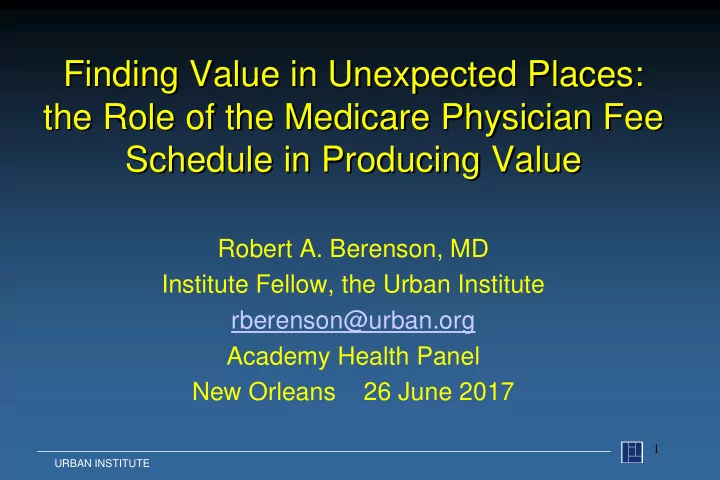

Finding Value in Unexpected Places: the Role of the Medicare Physician Fee Schedule in Producing Value Robert A. Berenson, MD Institute Fellow, the Urban Institute rberenson@urban.org Academy Health Panel New Orleans 26 June 2017 1 URBAN INSTITUTE
HHS Framework for the Evolution of Payment Models • Category 1 — fee-for-service with no link of payment to quality • Category 2 — fee-for-service with a link of payment to quality • Category 3 — alternative payment models built on fee-for-service architecture • Category 4 — population-based payment “Value -based purchasing includes payments made in categories 2 through 4.”
HHS Jan 26, 2015 “Historic Announcement” of Goals and Timeline for Value Payments • 30% of traditional Medicare payments tied to value thru APMs (categories 3,4) by the end of 2016, and 50% by 2018 • 85% tied to value (categories 2-4) by 2016 and 90% by 2018 • CMS says these targets are already being met on time or actually ahead of schedule • But only a relatively small percentage of spending – << 10 percent – are paid based on these “value” methods
Original CMS/LAN APM Framework 4 URBAN INSTITUTE
From G. B. Shaw, the Doctor’s Dilemma (1909) “That any sane nation, having observed that you could provide for the supply of bread by giving bakers a pecuniary interest in baking for you, should go on to give a surgeon a pecuniary interest in cutting off your leg, is enough to make one despair of political humanity. But that is precisely what we have done. And the more appalling the mutilation, the more the mutilator is paid. He who corrects the ingrowing toe-nail receives a few shillings: he who cuts your inside out receives hundreds of guineas, except when he does it to a poor person for practice.” 5 URBAN INSTITUTE
Attributes of fee schedules Advantages • Rewards activity, industriousness • Theoretically can target to encourage desired behavior • Implicitly does case-mix adjustment • Commonly used by payers and physicians Disadvantages • Can produce too much activity, physician-induced demand • Maintains fragmented care provided in silos • High administrative and transaction costs • What is not defined as payable is marginalized • Complexity makes it susceptible to gaming and to fraud • Susceptible to pricing distortions that alter intended effects 6 URBAN INSTITUTE
Reasons for repairing the MPFS even if one’s goal is value -based payment • Fundamental alternatives are not so easy – operationally or politically • In the most optimistic case, unlikely to achieve 100% replacement • Some successful payment models use fee schedules in hybrids – e.g., Denmark for primary care – ~60% fee schedule, ~40% capitation, with some P4P (like CPC+, track 2) – Attempts to achieve payment neutrality to encourage intrinsic motivation to do the right thing, rather than having payers externally driving behavior and in the process perhaps compromising professionally-based motivation • Current payment rates are used to calculate APM payment rates, so price distortions would be exported to the new rates • Health systems and medical groups commonly use work RVUs in their own compensation models – even when receiving capitation • Wide divergence in fee schedule-based, doc incomes makes medical group integration and collaboration more difficult 7 URBAN INSTITUTE
The statutory basis for the RBRVS-based MPFS constrains improvement options • RVUs are supposed to estimate relative resource costs, not the value to the program and Medicare beneficiaries of services rendered, such as whether they are getting the right mix of physician services or whether the workforce meets the needs of an aging society • Now, most policy considerations must be statutorily based, e.g., the 10% temporary add-on for primary care Evaluation & Management services in shortage areas • CMS can’t alter fees to produce a better mix of services but could with requisite statutory changes (but can add codes) • Policy considerations might include price-volume effects , meeting priorities (more geriatricians), etc. 8 URBAN INSTITUTE
Getting the times right would go a long way to correcting RVU misvaluations • Some examples of inflated times Service Time (in mins.) Liquid Nitrogen Freezing of a single lesion 23 Aspiration and injection into a knee joint 21 Colonoscopy with polyp removal 78 Twelve sector prostate needle biopsy 65 Abdominal ultrasound 21 EKG, interpretation and interpretation 6 • Many 90-day global surgical procedures assume many more follow up visits than actually occur 9 URBAN INSTITUTE
Specific improvement opportunities would address broader concept of value • CPT code definitions for E&M services need to be overhauled based on research demonstrating how physicians actually spend their time. – Most attention has focused on the RUC, but the CPT editorial panel and CMS decisions on what codes to recognize for payment deserve attention – Current code descriptions permit easy up-coding, and the intrusive “documentation guidelines” which actually promote up -coding via cut-and- paste in EHRs. These in turn have compromised the potential of EHRs which are overly oriented to documentation rather than decision support – CMS since 2014 has created a number of new HCPCS codes which they had resisted for years – transition care, complex chronic care management, “collaborative” care for behavioral health problems, diagnosis of cognitive impairment, advance care planning, other • Relying on empirical time data rather than unreliable, biased surveys as the central basis for determining work RVUs 10 URBAN INSTITUTE
Recommend
More recommend